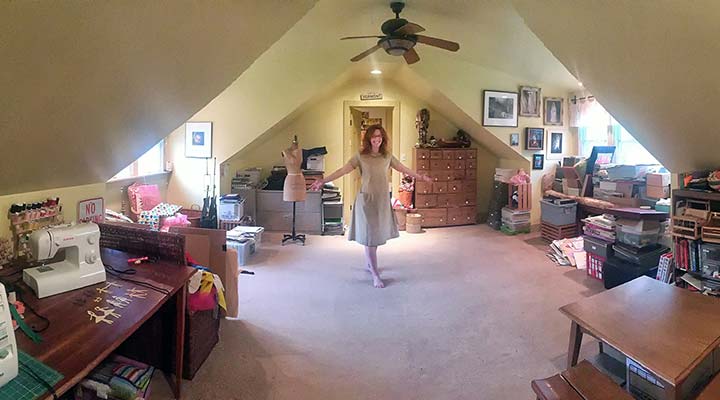
Have Too Much Stuff? How to Spot and Stop Clutter Habits
Mar 31, 2023 / Alyssa Duranty
Ever since she was a kid, Eve Schaub knew she loved to collect things. But what started with a few rocks and hotel soaps when she was younger eventually grew into large piles of unused things – from papers to craft supplies. She had too much stuff and her junk drawer grew to a junk room, so she vowed to finally clean out her spare room that had become so cluttered it was hard to open the door.
“I’ve always been fascinated with stuff, and I am very sentimental and attached to things,”; she said. “We had a large, empty room that wasn’t dedicated to anything in particular. It ended up the 'put it in there room,’ and that’s very dangerous when you’re a 'stuff person’ like me.”;
Every year it was her New Year’s resolution to clean the spare room, but every year she failed. That was until the room’s paths disappeared and the piles began to fall onto the door. She started organizing just 15 minutes a day, and eventually the floor reappeared.
“The timer would go off, and then I started to have good feelings. All I wanted to do was shut the door and get as far away as possible. But I focused on that space and felt really good when I saw the emptiness of that space, so invariably I would end up staying longer in the room,”;said Schaub, the author of Year of No Clutter.
If you relate to Schaub and want to learn some of the reasons we’re prone to clutter and how to overcome them, keep reading for advice from a professional organizer and psychologist. Both work with individuals on the television show Hoarders and help other clients to face their fears and disorganization.
Buying Unneeded Items that Pile Up

Now, more than ever before, it’s easy to buy things and have too much stuff. Stores are easy to find, and a world of goods is right at your fingertips thanks to the internet and credit cards. But buying too much stuff and keeping what you don’t need are leading clutter offenders, our experts say.
“We have a great consignment shop in the next town over, and it can be really dangerous,”; said Schaub. “I think: 'There’s only one here and it’s a great price, and if I bought it new it would be four times that.’ But I have to have conversations with myself and say: 'Do you really need that new chair and where it go and what would it replace?'”;
Schaub said she had to retrain her brain to only buy what she needs or has space for, a technique that Geralin Thomas, of Metropolitan Organizing, helps her clients learn through the organizing process.
“When you’re in people’s closets and homes, you hear all the excuses for keeping things,”; said Thomas, who authored From Hoarding to Hope: Understanding People Who Hoard and How To Help Them. “Disorganization comes in all flavors, all sizes and all shapes.”;
She recommends to break the buying cycle by going on a month-long shopping fast.
“Tour your house and think about clutter,”; she said. “Agree that no more stuff is going to come into the house. No shopping or acquiring anything, unless it’s grocery related, for 30 days.”;
Keeping Things to Go Green
Many people would rather keep their clutter instead of throwing it out and contributing to waste, said Thomas. It’s something that former clutter-collector Schaub can relate to.
“You see potential in everything, everywhere when you’re a DIY kind of person,”; she said. “I’m a big proponent of getting rid of things anywhere but the landfill. I want things to go to a good home where it will be loved.”;
It’s a common thought process that leads to clutter and disorganization, but it can be avoided by donating unused goods or selling them online. This is a great way to start the decluttering process, said Dr. Robin Zasio, a clinical psychologist who wrote The Hoarder in You: How to Live a Happier, Healthier and Uncluttered Life.
“You need to have a process on how to get rid of (clutter),”; she said. “Every Friday after work, go to the recycling place and neighborhood donation centers. Don’t relocate stuff. Have a plan to get stuff out of the house.”;
“The biggest offender is people procrastinate,”; she added. “People have great ideas but never execute them. So, ask yourself: 'What do you want your life to look like, and what can you do to make your environment match those values.'”;
Attaching Sentimental Value to Too Many Things
Recently, Schaub found her grandmother’s old blender in her attic. A sentimental person, she would have likely stored the keepsake in her spare room. But instead, she gave it to a local theater group to use as a prop in upcoming plays.
“I talk myself off the ledge and use my rational side of my brain, and reminding myself of my goal helps,”; she said.
To help her clients give up some objects that have sentimental attachment, Thomas reminds them that memories last even when object go.
“Losing those things isn’t disrespectful to the person that gave them that gift or item,”; she said. “They want the organizer to believe that everything is precious and special, but when you have that much stuff nothing is special. If you’re hanging on to 30,000 photos, none of them are special.”;
To keep her client’s keepsakes down to a manageable amount, Zasio has them set a limit, maybe one or two boxes, to store them in. If they don’t fit, they don’t stay, and that’s a great way to determine importance.
“Most people don’t spend time with photo albums and other keepsakes as they expect to,”; she said. “If it doesn’t fit in the box, take a picture of it. Email it to yourself and keep it in a folder, so the things don’t take up physical space.”;
To conquer her cluttered, spare room, Schaub said she had to change the way she saw stuff and to overcome the fear of tossing something she might want or need later. It’s something she said anyone with too much stuff can do too, with time.
“The muscle in the brain that makes decisions had atrophied,”; she said. “Instead of making a decision, I avoided it because I was afraid of making a bad decision. I gave myself permission to make mistakes.”;
And in the end, her focus and determination paid off.
“There was a wonderful moment when the (spare) room transformed,”; she said. “I came into the house, and I didn’t know where my kids were. Then my younger daughter yelled out 'We’re in the art room!’
“All of a sudden, the room was used for a real purpose and the objects were not in control.”;
Photo above courtesy of Stephen Schaub.







